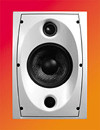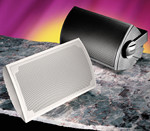Backyard Bonanza Page 3
 Klipsch SA-1 ($429/pair)
Klipsch SA-1 ($429/pair) The SA-1 is the entry-level model in Klipsch's outdoor lineup. It features a two-way, ported-cabinet design with a 4-inch square Tractrix Horn coupled to a 1-inch dome tweeter next to a 5.25-inch woofer. The SA-1's ported design and high-frequency horn help provide a wider dynamic range and higher bass output, but the port could be problematic in some installations, so beware. The designers obviously feel that the port's sonic benefits outweigh the potential mounting drawbacks. The perforated grille covers nearly the entire front of the speaker (including the ports, so they're safe from most bugs). In my opinion, the full grille gives the SA-1 a more-neutral appearance when it's mounted in a visible area.
 Due to the tweeter's controlled-dispersion characteristics, the SA-1 is designed to be installed horizontally. The bolts that hold the speaker in the mounting bracket are unusual in that they attach to the speaker itself, not to the thumbscrews that go on outside the bracket. This is a little thing, but it can mean a lot when you're up on a ladder trying to install a speaker. With most outdoor speakers, after you screw the bracket in place, you have to hold the speaker with one hand while you try to find the screw hole in the bracket (and then the one in the speaker) for the thumbscrew. It's a task best accomplished with three hands. With the SA-1, after you've screwed the bracket in place, all you have to do is slide an end bolt into one of the openings in the bracket, bend the bracket out slightly, and slide the other bolt into place. The bracket holds the speaker in place while you install the thumbscrews on bolts that are easily found. Unfortunately, there are no drain channels around the speaker terminals.
Due to the tweeter's controlled-dispersion characteristics, the SA-1 is designed to be installed horizontally. The bolts that hold the speaker in the mounting bracket are unusual in that they attach to the speaker itself, not to the thumbscrews that go on outside the bracket. This is a little thing, but it can mean a lot when you're up on a ladder trying to install a speaker. With most outdoor speakers, after you screw the bracket in place, you have to hold the speaker with one hand while you try to find the screw hole in the bracket (and then the one in the speaker) for the thumbscrew. It's a task best accomplished with three hands. With the SA-1, after you've screwed the bracket in place, all you have to do is slide an end bolt into one of the openings in the bracket, bend the bracket out slightly, and slide the other bolt into place. The bracket holds the speaker in place while you install the thumbscrews on bolts that are easily found. Unfortunately, there are no drain channels around the speaker terminals.
By far, the SA-1 was the most efficient of the speakers. I didn't find it to be the most accurate, though: There was a definite midbass bump, and the highs were a little too aggressive for my taste. Still, I kept coming back to it as the most enjoyable one to listen to. With music from the Red Elvises and Fiona Apple (stuff I'd play for friends if I ever had any to invite over for a party), the sound just clicked. The Boston Acoustics and Niles speakers might be better-suited to a larger area needing multiple speaker pairs; however, on my patio, the pair of Klipsch SA-1s really kicked.
 Niles Audio OS-10 ($399/pair)
Niles Audio OS-10 ($399/pair)
Niles is a great name for a butler. Sadly, the OS-10 can't straighten your house before or clean up after a wild party. It can make the outside of your home look good, though, with its rounded sides and aerodynamic shapeliness. Behind its narrow grille is a sealed, two-way system with a 1-inch dome tweeter and a 5.25-inch woofer—both of which are rear-mounted drivers. The OS-10 is just a tad bigger than the Boston Acoustics Voyager Pro and about average in efficiency. Niles is a very popular brand with custom installers, and features like drainage channels around the input terminals, a hole for the speaker wire in the included U-shaped bracket, and prethreaded inserts for alternate brackets are some of the reasons why. At a little over 6.5 pounds, it's one of the lightest speakers of this bunch—an important factor when mounting up high.
Its high frequency was smooth, and its bass response was taut, but I found the OS-10 to be just a bit lacking in the midrange. Overall, though, it was an excellent performer—definitely one to consider for multispeaker installations.
 Sonance Mariner 300 ($499/pair)
Sonance Mariner 300 ($499/pair)
Sonance's Mariner 300 is a two-way, ported-cabinet speaker that matches a 0.75-inch aluminum-dome tweeter with a 5.25-inch carbon fiber-cone woofer. As with the SA-1, you'll want to exercise some care in placement to prevent direct streams of water from getting into the port opening. The Mariner 300 offers the most flexible mounting bracket of all the speakers listed here. It's called a multiaxis pivot bracket because it allows the bracket to be tilted along two axes (left/right and up/down). This unique bracket lets you compensate for less-than-optimum speaker placement, which might be dictated by physical or cosmetic considerations. The thumbscrews aren't quite as comfortable to tighten as the ones on the Voyager Pro, but they're close.
The Sonance gives the Klipsch a good run for its money in the dynamics department. There's no lack of bass, either, but the highs weren't quite as pronounced or articulate as they were with the Klipsch. This is perhaps the most chameleonlike of all the models, with an interesting ability to sound good in just about any application.
 Definitive Technology AW100 ($399/pair)
Definitive Technology AW100 ($399/pair)
Definitive Technology's AW100 is a sealed, two-way speaker based on the company's ProMonitor 100 bookshelf speaker. This version uses a special 1-inch aluminum-dome tweeter and 5.25-inch woofer. It's downright tiny (10 inches tall and less than 6 inches wide and deep) compared with the rest of this group, so it will fit inconspicuously in more places. It also has a uniquely small mounting bracket that's only 1.5 inches wide, so it will fit on the short side of a two-by-four. The bracket attaches to the bottom of the speaker using a single thumbscrew (about average in its ease of tightening), and the speaker's rounded back allows you to turn it a full 180 degrees without making it overly conspicuous. Depending on the angle of installation, some water could collect around the speaker terminals, but not much, thanks to the grooves on the back of the cabinet.
The AW100's size is definitely a strength, but it's also a weakness. The bigger speakers like the Klipsch and Boston Acoustics models provide more bass output, but the clarity of the Def Tech's midrange and highs is very seductive. Multiple pairs of AW100s with an in-ground subwoofer would be an awesome combination for large areas.
Looking back at each of the speakers, it's pretty tough to pick a clear winner. Overall, I really liked the energy of the Klipsch SA-1. For the small patio area I needed to cover, it had just the right mix of punch and pizazz for casual entertaining. I also enjoyed the accuracy and tonal balance of the Boston Acoustics Voyager Pro. If I just needed a speaker for private listening, I'd definitely be tempted to go with this one. The Definitive Technology AW100 was very sweet and natural, but I'd want a subwoofer to accompany it. Finally, the Niles and Sonance models were excellent contenders, and they'd probably be the choice if I needed to cover a larger area with multiple pairs of speakers.




























































